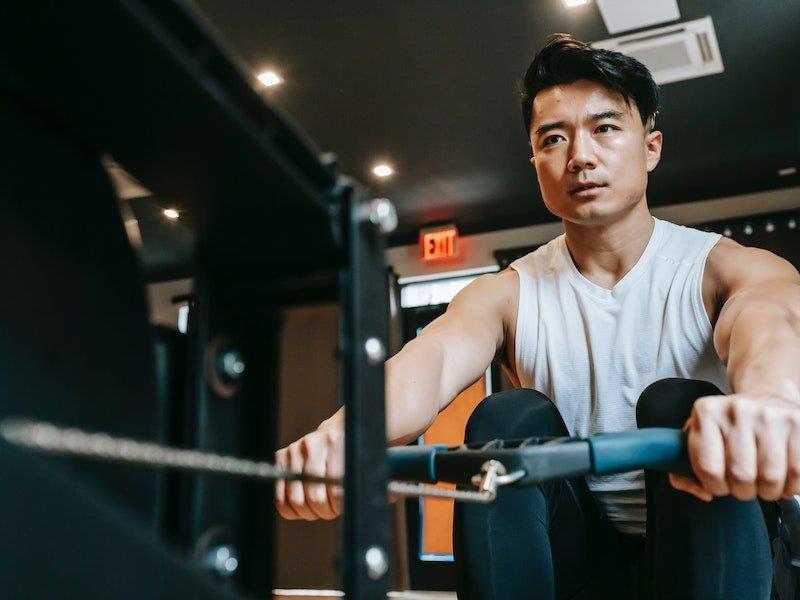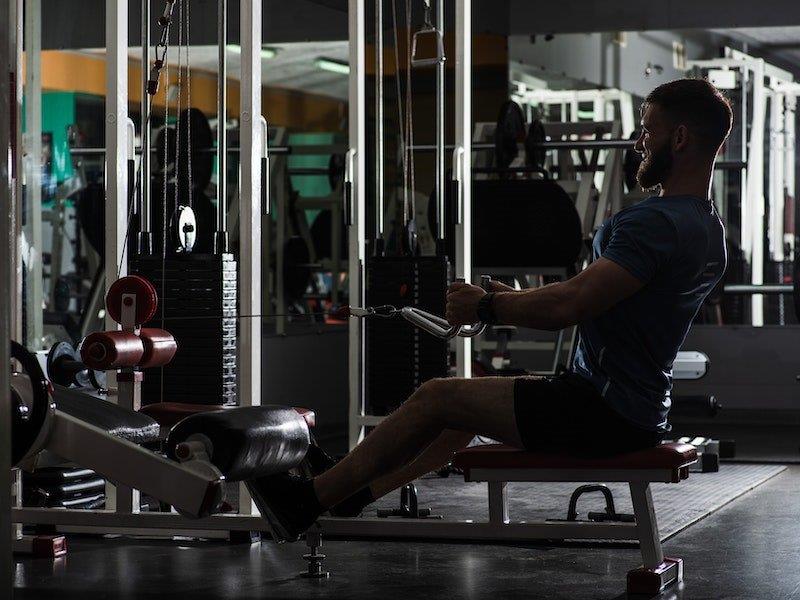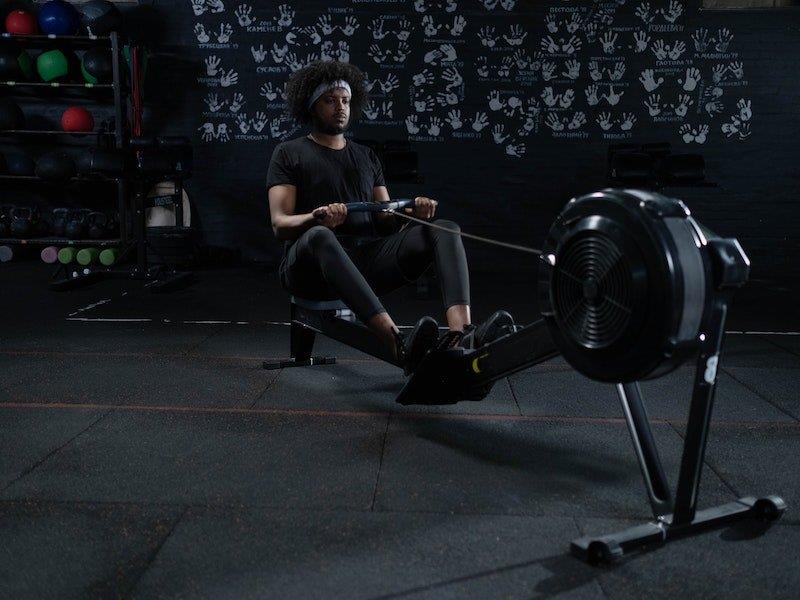If you’re looking for a total-body workout, we highly recommend rowing. Rowing is one of our favorite types of cardio – it’s low-impact and can honestly be a little meditative.
Having your own rowing machine at home is a great way to get in this great exercise without having to hit the water every time. You don’t need any prior experience to start rowing, so this piece of equipment is perfect for both newbies and experienced rowers.
In this complete guide to buying rowing machines, we’ll tell you everything we know about choosing the right machine as well as other things to consider before making your purchase.

How to Choose the Right Rowing Machine
There are a few different things to consider before choosing a rowing machine, from purpose to features.
Residential vs. Commercial Machines
Yes, you’re going to be rowing, but not all machines are built the same. You want to pick the best one for your own personal purposes.
If you plan to share this machine with friends or family members, we recommend considering a commercial-grade rowing machine. These machines are more heavy-duty than traditional at-home machines. While they’re normally bought for commercial gyms, they work well in large families since they’re designed to withstand heavy use.
Type of Resistance
There are a few different types of rowing machines. The type of resistance determines the type of machine you have. The main types include:
- Air resistance
- Water resistance
- Hydraulic resistance
- Magnetic resistance
We’ll go over each of these types in more detail below. For now, you should know that each type has its own pros and cons.
If you want something to prepare you for real on-the-water rowing, for example, you should opt for a water resistance rowing machine. So choose a resistance for the type of workout you want.
Height and Weight Capacity
Your rowing machine should suit your body type. This will ensure that your workouts are safe and comfortable.
Weight capacities on rowing machines can range anywhere between 250 and 500 pounds. Typically, machines with higher weight capacities are built sturdier than ones with lower capacities. Even if you don’t need a weight capacity that high, a higher capacity may result in a longer-lasting machine.
Rowing machines also have different lengths. This is especially important to note if you’re particularly short or tall.
Hydraulic rowers tend to be the smallest type of rowers, averaging around 50 inches in length. Air, water, and magnetic rowers tend to be much longer. You can expect these to be anywhere between 85 and 92 inches in length.
Most rowing machines are adjustable to some extent, but make sure the size and length you choose will work for your body type.
Motivating Features
Just like any other at-home exercise machine, some rowing machines come with special added features. These may include digital screens, electronic attachment points, and personalized workout settings.
If you want to follow along with rowing training videos, such as the video below by Dark Horse Rowing, you may want to choose a machine that already has a screen or subscription with it. Check for features such as touchscreens or gamified content that may encourage you to exercise more regularly.
These features may be more expensive, but we find that they’re worth it if you need the motivation.
Types of Rowing Machines
As mentioned before, there are four main types of rowing machines. You should choose your machine based on the type that fits your needs best according to their pros and cons.
Air Resistance
Air resistance rowers are the most common type of rowing machines. These machines use air resistance in the flywheel to help you get a solid workout.
When using an air resistance rower, the resistance depends on how hard you pull. If you pull very hard, you’ll get more resistance.
These rowers are popular because they have extremely smooth strokes compared to other machines. Your workout is also dependent on your own strength, so you don’t need any fancy settings or adjustments.
However, they are louder than other machines due to the fan blades, so they’re not great if you live in a shared space. If you like combo machines, you could also try out an air- and magnetic-resistance machine.
Water Resistance
If you want a rowing machine that feels like you’re really out on the water, go for a water rower. Water rowers feel much closer to the real thing, as they use water for resistance instead of air. Just like air resistance machines, the intensity of the resistance depends on how hard you’re pulling.
Because the paddles move through water instead of air, it feels incredibly similar to rowing on an actual lake or river somewhere. Though you can still hear the water as you work out, some users find it quite peaceful as it both feels and sounds like you’re out in nature.
Because of their realistic nature, they tend to be the most expensive rowing machines on the market. They tend to be best-suited for experienced rowers or those who train to actually get out on the water.
Hydraulic Resistance
Hydraulic rowing machines are great for those with limited space or mobility. They’re often much smaller than the other types of rowers, which makes them easy for storing or placing in small spaces.
Because of their limited size, hydraulic rowers only work out your upper body. You pull a lever to work out, and the resistance is adjustable on the machine.
Though you won’t be able to work out your legs, hydraulic rowers are extremely quiet and are the most affordable rowing machine type out there.
Magnetic Resistance
Magnetic rowers offer greater levels of resistance than other rower types. Because they use magnetic force against the flywheel, they create consistent resistance that you don’t get from other rowing machines.
Because of this, the strokes on a magnetic rower are quite smooth. Resistance also tends to be greater when rowing slowly, rather than quickly due to the magnetism. They’re durable, quiet, and don’t need much maintenance compared to other models.

Other Things to Consider Before Buying a Rowing Machine
The type of resistance and special features aren’t the only things to consider before bringing home a rowing machine. Here are our top things to remember before you make that big purchase.
Space and Storage
Rowing machines come in vastly different sizes. You need to consider the space you have available before choosing a rowing machine.
If you have very limited space, such as in a small apartment or spare room, you may want to opt for a hydraulic rower. Though these machines are less intensive than others, they’re the most compact and perfect for smaller spaces. They also store easily because of their compact size.
If you have a larger area to put the machine, such as a home gym, you can consider larger machines like water resistance rowers.
You should also take a look at foldability. Some rowing machines can be folded for even easier storage, which is great if you need it out of the way sometimes. However, some models can’t be folded or even turned on their side, so look carefully at storage requirements.
Cost and Budget
Rowing machines can cost a pretty penny depending on the model you aim for. If you’re only using it for casual home use, don’t feel like you need to spend thousands of dollars on a machine!
In general, you can find a pretty good machine for under $400. However, these tend to be on the lower end of the scale. So, they might not have as many bells and whistles as more expensive models.
Anywhere between $500-700 tends to be mid-range and offers you high quality and some decent features without breaking the bank too badly. These machines tend to last pretty long, too, depending on their build.
If you’re a more advanced rower or want only the best of the best, you can expect to spend anywhere between $1,000 and $3,000 (and sometimes even more!) on a machine. These machines are usually built with the most durable materials and are designed for heavy use. They also tend to last longer than cheaper machines.
Note that quality and price don’t always match up perfectly. You can find some really great machines at more affordable rates, and some pretty bad ones at more expensive rates. It all depends on the build, weight capacity, features, and brand offering the machine.
Always look at specifications and reviews for any machine before making a purchase. These can tell you a great deal about the quality of the machine you’re considering compared to the price.

Build Quality and Materials
There are several different materials that can be used to build a rowing machine. The most common are hardwood, steel, and aluminum.
Aluminum tends to be the cheapest, offering a combination of affordability and durability. Steel is the most durable, though, and tends to last much longer than other materials.
Some rowing machines are made of hardwood to provide a more pleasing feel to them, as this can make them feel more like an actual boat. Wood will require more maintenance over time, but they tend to also be the most attractive rowing machines out there, as their stunning hardwood makes them appear more decorative than other builds.
The sturdier and more durable the build is, the longer your machine will last.
Comfort
If you aren’t comfortable during your workout, you’ll be less likely to use your machine regularly.
Make sure your machine is the right size for you in length and weight. If you’re too tall for your machine, you may end up with cramped legs and an inefficient workout. You should also adjust the seat and settings to be comfortable for your height.
If you’re a larger user, look for rowing machines with wider footplates and handles. These tend to give you some more room to work with and can reduce the risk of cramping and discomfort.
Some machines also have extra padding to sit on, for greater comfort on your bottom. If possible, try to find a rowing machine in person so you can sit on it and see if it is comfortable for you.
Final Thoughts
Buying a rowing machine can give you access to a thorough workout any day of the week. Remember that before buying one, you should be sure to think about the type of machine and features you want. From resistance type to budget, there’s a lot to consider before making your purchase.
To go along with your machine, take a look at our article on getting a mat for under your rowing machine to protect you flooring or neighbours sanity. The right mat will protect your floor so you can row in peace.
FAQ
1. Is one type of rowing machine better than others?
No one rowing machine is better than others. Your choice lies in your specific needs and preferences. If you’re having a hard time choosing, you can always consider a hybrid machine. These machines use both magnetic and air resistance to give you the best of both worlds.
2. What muscles does a rowing machine target?
Rowing machines target your abs, upper and lower back, shoulders, biceps, triceps, glutes, hamstrings, calves, and quads. Really, a full rowing machine can target all of your major muscles for a full-body workout.
The only exception to this is a hydraulic rowing machine, which only targets your upper body.
3. How long should I work out on a rowing machine?
The time you spend rowing depends on your level of intensity. For a basic cardio workout, 30 minutes per day is a great rule of thumb for workout length. If you’re doing a high-intensity workout, you could reduce this time to around 15 minutes, though. We recommend doing this routine 4-6 times per week.
If you’re using your machine for training or serious weight loss, you can exercise anywhere from 40 minutes to an hour. Be sure to not overdo it, as you don’t want to strain your muscles or hurt yourself.
